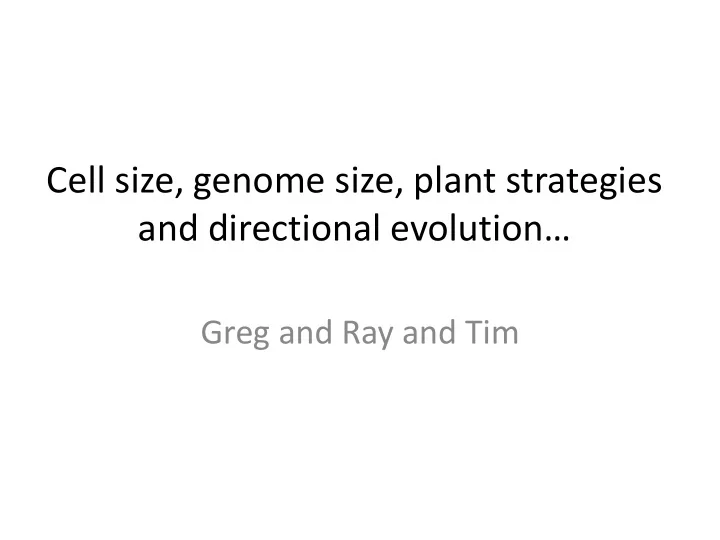

Cell size, genome size, plant strategies and directional evolution… Greg and Ray and Tim
Proteaceae are the best organisms in the world
a short stroll through leaf anatomy Palisade Leaf (lamina) Vein thickness Vessels Epidermis see detail…
Detail of an epidermis Epidermal cells stomate
Epidermis in surface view small epidermal cells big epidermal cells small stomates big stomates high stomatal density low stomatal density
paradermal section showing vein density
a short stroll through leaf anatomy Palisade cells Leaf (lamina) Vein thickness Vessels Epidermis with stomata
unified changes in leaf cell size (across 80 million years!) epidermal cell size stomatal size palisade cell size vessel diameter significant correlations phenotypic leaf thickness phylogenetic
Do we expect directional evolution * Systematic changes over the Cenozoic (last 65 million years)
Stomatal size affects photosynthetis
packing density and stomata 90 stomatal length ~ 80 1/√stomatal density 70 stomatal length ( μ m) 60 50 40 hypostomatic species 30 20 amphistomatic species 10 0 0 200 400 600 abaxial stomatal density (mm-2)
small stomata are more efficient • per stomate conductance scales linearly with size • number of stomates scales 1/quadratically with size • small stomates lead to high conductance
functional links 1/stomatal size vein 1/vessel density size matching water supply packing (veins) constraints and demand (stomata) stomatal density
Expected directional evolution 1 CO 2 model – low CO 2 = a need for greater conductance – small stomata are more efficient – guard cell size should have decreased
genetic link 100 guard cell length (microns) Grevilleoideae Persoonioideae + Bellendena Proteoideae + Symphynematoideae 10 0.9 9 90 genome size pg • genome size • other genetic factors
Do we expect directional evolution 1 CO 2 model – low CO 2 = a need for greater conductance – small stomata are more efficient – guard cell size should have decreased 2 genome size model – genome size drifts up (one-way path to obesity) – Guard cell should have increased
• strong evolutionary association with open vegetation (versus rainforest) • leaf thickness • stomata on both leaf surfaces
Do we expect directional evolution 1 CO 2 model – low CO 2 = a need for greater conductance – small stomata are more efficient – guard cell size should have decreased 2 genome size model – genome size drifts up (one-way path to obesity) – Guard cell should have increased 3 ecological model – follows changes in habitat – mostly increase - as woodland replaced rainforest
So, what has happened to stomatal size through time? • ancestral state analyses • fossils
ancestral state reconstruction
scatter plot of reconstruction versus age for each node 100 guard cell length ( μ m) - log scale 10 0 25 50 75 Time (millions of years ago)
but fossils say 100 guard cell length ( μ m) - log scale ancestral states fossils 10 0 25 50 75 Time (millions of years ago)
and it happens within clades Banksieae 40 35 guard cell l length ( μ m) 30 25 20 15 10 fossil 5 ancestral states 0 0 20 40 60 80 Time (millions of years ago
directional evolution • driver either – habitat shift with global climate change – systematic trend in genome size • invalidates the ancestral state reconstructions
Recommend
More recommend